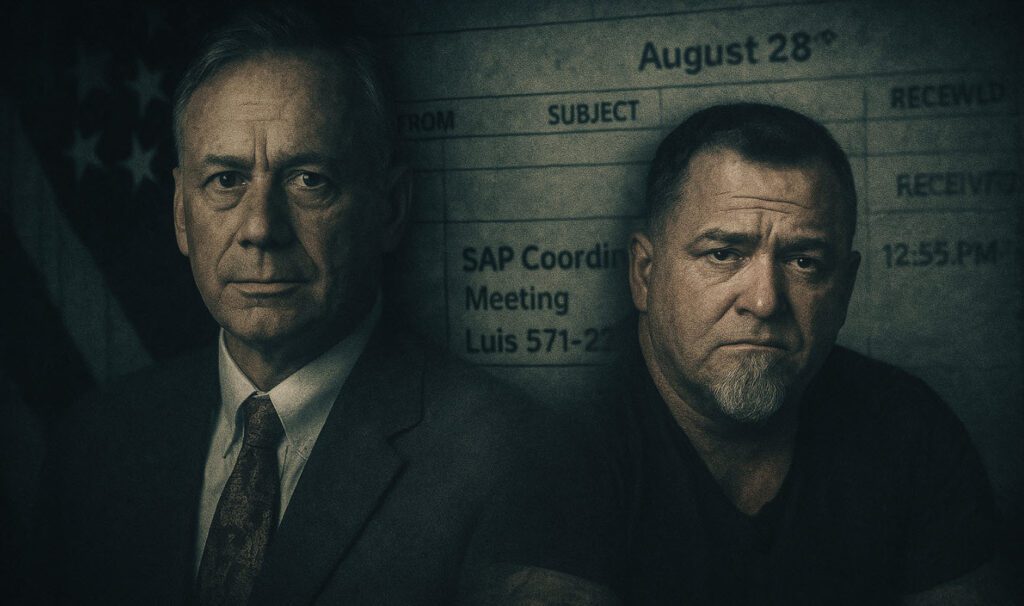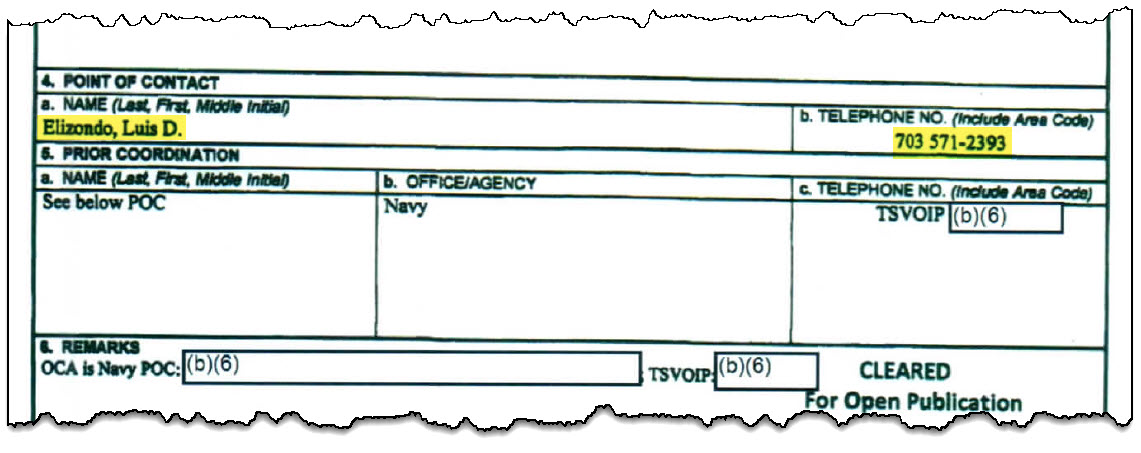
A newly released Freedom of Information Act (FOIA) response from the Office of the Secretary of Defense (OSD) has revealed that no records exist for an August 28, 2017, meeting listed on the official calendar of Neill Tipton, then Director for Defense Intelligence, Collection and Special Programs.
The finding stands in contrast to an earlier FOIA-released calendar showing the meeting was scheduled as an UNCLASSIFIED “SAP Coordination Meeting,” with a point-of-contact phone number matching one found on Luis Elizondo’s DD Form 1910 request to release three Navy UFO videos back in 2017.
OSD’s “no records” determination, issued today to The Black Vault under FOIA case 24-F-0839, asserts that a search of OUSD(I&S) systems “could reasonably be expected to produce the requested records if they existed,” but that none were identified when it came to seeking out records relating to the meeting.
The Black Vault immediately appealed the decision, arguing that the agency overlooked evidence already released under FOIA case 20-F-1026, as filed by Lt. Tim McMillan, co-founder of The Debrief, which documented the meeting on Tipton’s official schedule.
That release to McMillan showed:
“SAP Coordination Meeting (UNCLASSIFIED) — Luis, 571-2393.”
The same phone number appears on Elizondo’s DD Form 1910 as his Pentagon office line at the time he submitted UFO videos known today as “FLIR1,” “Gimbal,” and “GoFast.”
The presence of the phone number in both documents, combined with a claim in Elizondo’s DoD IG complaint that he briefed Tipton in the July–October 2017 period, has fueled long-standing questions about whether the meeting took place, what it was about, and now, why OSD says no records exist.
The Tipton calendar released in FOIA case 20-F-1026 spans August 2017 and includes a clear entry at 12:55 p.m. on August 28, 2017, indicating a meeting took place between Tipton, and likely Elizondo himself.
These types of calendar entries are government records typically retained within OUSD(I&S) systems, which generally indicate that related materials exist such as:
-
Scheduling emails
-
Briefing papers
-
Read-ahead materials
-
Meeting notes or summaries
-
Follow-up taskings
The FOIA appeal filed by The Black Vault argues that federal case law establishes that agencies must search all locations where related records are likely to be found, especially when an existing record points directly to their existence, like this calendar entry does.
OSD stated it could locate no responsive materials, even though this official calendar entry clearly confirms the meeting was at least scheduled at one time. Under normal circumstances, even a cancelled or preliminary meeting would generate minimal administrative records, all of which would be responsive to The Black Vault’s request.
In Elizondo’s May 2021 complaint to the Department of Defense Inspector General, he states that between July and 3 October 2017, senior Pentagon officials directed him and a colleague to brief Neill Tipton on the status of AATIP and to transition responsibilities to him. Elizondo states:
“From July to late September, Mr. [Brennan] McKernan and I had several personal meetings with Mr. Tipton to brief him on the nuances of AATIP.”
“Mr. Tipton agreed to assume the management role of AATIP…”
The complaint frames these meetings as part of a coordinated handoff of AATIP responsibilities, which has become a central element in Elizondo’s public claim that he led the program. But the Pentagon has consistently stated:
“Luis Elizondo had no assigned responsibilities for AATIP.”
The Pentagon’s position has remained unchanged for years, and to date, no document has been released that places Elizondo within any official program titled, or nicknamed, the Advanced Aerospace Threat Identification Program (AATIP). The Tipton calendar entry has been one of the few government-generated materials cited as potential evidence of interaction between Elizondo and senior OUSD(I&S) leadership on UAP-related matters, but still does not definitively prove that the meeting was AATIP, or even UAP, related.
But additional context to this meeting may emerge from email exchanges between Tipton and Elizondo, as published in Elizondo’s DoD/IG complaint. These messages, dated August 22–25, 2017, fall just days before the August 28 calendar entry and depict active communication about a planned meeting, efforts to schedule it, and discussions of an unspecified portfolio Elizondo described as “nuanced.”
In a message sent on August 22, 2017, Elizondo informed a Navy counterpart that he had spoken with Tipton “about our collective efforts” and recommended an in-person meeting once staff returned from leave. Tipton was copied and described as “amicable for a discussion” in his role as Acting Director for Defense Intelligence, Technical Collection and Special Programs. This message, which explicitly references coordination among OUSD(I), the Navy, and others, demonstrates that meeting preparations were already underway.
Tipton replied the following morning, August 23, adding a staff member to assist with scheduling. Elizondo responded on August 25, thanking Tipton “as discussed” and asserting that Tipton, as the “principal SES” in his directorate, was the appropriate figure “to help take our effort to a new level.” Elizondo further stated he had been managing another “nuanced effort within the Department for some time,” and that he had already “laid the foundations with SECDEF’s front office” to transfer this portfolio under Tipton’s oversight. He referenced meetings at the “front office,” partners in industry and other agencies, and the need to analyze and exploit material, an apparent reference to ongoing technical or operational work. Tipton replied the same morning: “Thanks Lue. All good – although, at some point I need to know what this actually ‘is’…”
Additional insight comes from a September 11, 2017, email, where Elizondo informed Tipton that “the front office is aware that you are now part of this endeavor and they are happy with the decision,” then proposed meeting the following Wednesday for a one-hour discussion. He also referenced a colleague as “a friend of the program,” noting Tipton would be speaking with him the next day.
Tipton’s reply, positioned directly above Elizondo’s email in the FOIA release and evidently written within the same timeframe, stated: “Thanks Lue. I’m around next week… For specific date/time, just work with [redacted]. I’m not allowed to muck around with my calendar.” He added that he had “a discussion with [redacted]tomorrow,” which suggests he was already engaged on issues connected to the effort Elizondo was attempting to advance.
When read alongside the August emails, the September 11 exchange reflects a notable shift. In late August, Tipton had asked Elizondo, “at some point I need to know what this actually ‘is’…,” indicating uncertainty about the nature of the portfolio. By September, Elizondo was telling Tipton that senior leadership, aka the “front office”, supported his involvement. The progression documented in these emails does not identify AATIP explicitly, but it does show an evolving effort in which Tipton was being brought into a role with responsibilities Elizondo believed were being aligned under him.
Then, in a communication dated September 25, 2017, released via FOIA to The Black Vault, Elizondo sent Tipton a “DRAFT DepSECDEF letter” written “at the unclassified level” so Tipton could “better assume the new responsibilities for AATIP.”
Elizondo wrote that the memo had been drafted “per SECDEF’s Front Office guidance to you and me,” and asked Tipton for edits. Tipton replied on October 3, 2017, saying he would review and provide comments.
The attached draft memorandum, the now-public AATIP memo, is one of the only official DoD documents ever released that refers directly to AATIP. It outlines congressional funding for the program in 2008, describes its focus on “beyond next generation technologies,” and directs all DoD elements to provide reporting on “unexplained or unknown aerial systems” to the Director of Defense Intelligence for Technical Collection and Special Programs, the office Tipton held at the time.
Although the memo remains heavily debated in terms of its status and was clearly written by Elizondo and not the Deputy Secretary of Defense, the emails show that Elizondo was transmitting the draft to Tipton in late September 2017 as part of what he described as a transfer of responsibilities “to you and me” per guidance from senior leadership. Combined with Tipton’s acknowledgment on October 3 that he was “getting spun back up” and would review the document, the records finally demonstrate that AATIP was explicitly referenced in correspondence between the two men during this period.
Elizondo resigned later that same day.
Taken all together, these communications do not establish whether the August 28 meeting took place or what its precise subject was. They do, however, document an active dialogue from late August through early October, involving scheduling, follow-up discussions, and the transmission of a memo directly labeled “Advanced Aerospace Threat Identification Program.” The presence of these records strengthens the central question raised by the FOIA “no records” determination: if emails exist showing coordination between Elizondo and Tipton on a portfolio as directed by senior offices, why does the Department of Defense report that it can locate no material whatsoever associated with a meeting that appears on Tipton’s official calendar between him and Elizondo within that timeframe?
OSD’s letter states that its search would have found records “if they existed.” But the calendar entry, which the authenticity of is not in dispute, suggests they did, at one time, likely did exist. So where are they?
The documentation presents several possibilities about the August 28th meeting:
If the meeting occurred
Then associated records should exist somewhere within OUSD(I&S) or SAP coordination channels.
If the meeting was cancelled
There is still no explanation for why no scheduling emails or cancellation notices were located during the search.
If the meeting occurred but involved no Elizondo-related content
Responsive materials would still be expected under a FOIA request for all records “pertaining to” the event.
If records once existed but were later deleted or misplaced
That issue is not addressed in the FOIA response, and the appeal argues that OSD must examine alternative systems or archives.
This calendar entry remains one of the few official documents linking Elizondo to a senior Pentagon intelligence official during the period when he says he was transitioning AATIP responsibilities. The government’s position, reiterated for years, is that he had no assigned role in AATIP. The calendar entry does not resolve that contradiction, but it does establish that a meeting involving “Luis” at Elizondo’s known office number was officially recorded at a time it is confirmed Elizondo was talking to Tipton about transferring a portfolio.
With OSD’s latest FOIA search producing no related documents, the question becomes not just whether the meeting occurred, but how an official record of a scheduled SAP-related meeting can exist with no underlying materials preserved in any system searched by the Department of Defense.
The Black Vault’s appeal seeks clarity on all this, and requests a new search based on evidence and established case law requiring a proper one be conducted. Until that search is fully completed, the August 28, 2017, “SAP Coordination Meeting” remains a documented but unexplained artifact in one of the most debated chapters of the Elizondo/AATIP saga.
###
Document Archive
FOIA Response Letter
 Loading...
Loading...FOIA Release of Calendar to Lt. Tim McMillan
